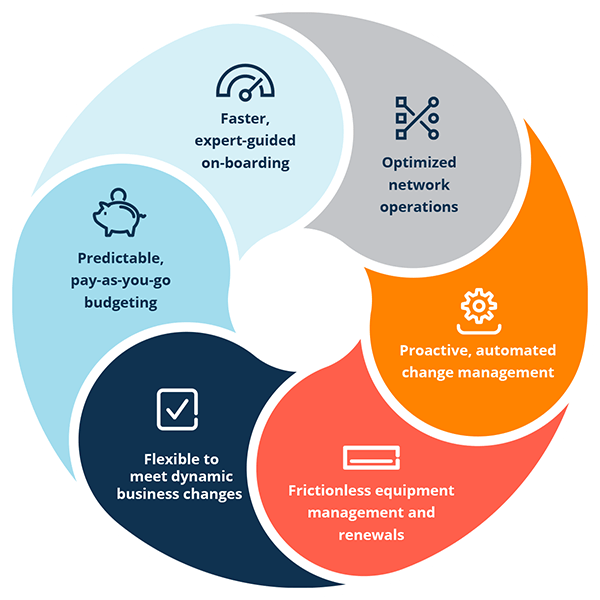NaaS, or “network as a service,” rents a computer network service to users. It refers to a kind of cloud service in which users lease networking resources from a third party. NaaS frees up businesses and individuals from the hassle and expense of building and maintaining their own intranets and extranets. NaaS suppliers, like other cloud service providers, operate networking operations in software, enabling businesses to build networks with no hardware. To do anything, they only need access to the web.
NaaS may be used instead of conventional network architectures such as virtual private networks (VPNs), MPLS links, and so on. It may also substitute for firewall appliances and load balancers installed locally. As a result, NaaS, a novel paradigm for directing network traffic and enforcing security regulations, has significantly affected corporate network design.
It may be difficult to set up and manage a wide area network (WAN), what with its WAN optimizers, routers and protocols, and other components like software-defined WAN endpoints and firewalls. With NaaS, a third-party supplier takes care of these tasks and makes them accessible to large businesses.
NaaS customers often come from smaller and medium-sized organizations that haven’t yet invested in a wide area network. However, with the proliferation of other service models over the last decade, bigger companies are starting to take notice. In addition, NaaS might be alluring to start-up company owners since it reduces the need for an initial funding of costly network infrastructure.

Fig 1: NaaS infrastructure
Image credit: cloudflare.com
Contents
When and Why Did NaaS Emerge?
The Internet was not a reliable location to do business when most companies were setting up their network infrastructure. This necessitated the development of proprietary intranets and the leasing of connections for inter-building communication. In addition, each branch office required its own firewall, DDoS mitigation, load balancing gear, and so on, and they had to set up their wide area networks (WANs). Companies also have to use MPLS or some other specialized inter-site connection technique.
When employees used an external Internet connection instead of the company’s private network, the company’s VPN routed all Internet traffic first. So, for example, if a company’s headquarters were in New Delhi and an employee in Chennai wanted to load a webpage, the request would make its way via the company’s VPN, through an MPLS connection to New Delhi (more than 2000 kilometers distant), and then out to the broader Internet.
As more and more functions of a company moved to the cloud, this strategy rapidly proved ineffective. For example, let’s say the Chennai worker often utilized a software-as-a-service (SaaS) program, which necessitated frequent content-loading operations. As a result, network service speeds will suffer due to their requests and those of other workers trying to access the New Delhi data center simultaneously.
Also, as cloud computing improves in efficacy, more features are becoming accessible through the cloud. The need for in-house IT departments to design and manage essential network services like distributed denial-of-service (DDoS) protection, firewalls, load balancing, and more has been eliminated in recent years thanks to cloud computing.
NaaS is more practical than depending on in-house WANs since the latter need ongoing maintenance and often cause bottlenecks in network traffic. In addition, NaaS allows a company’s workers to bypass the IT department entirely by connecting directly to their cloud services over a virtual network that is managed and secured by a third-party provider.
NaaS Advantages

Fig 2: Primary advantages of the NaaS model
Image credit: arubanetworks.com
NaaS is expanding as a business model in large part because Software-Defined WAN (SD-WAN) reduces the need for costly upfront investments and extensive time commitments from employees.
More Uptime: NaaS uptime guarantees address one of the biggest issues of modern businesses: reliability. SD-WAN technologies streamline the use of numerous network channels to offer connectivity back to the NaaS backbone and perhaps directly to other NaaS sites throughout the internet. Uptime worries may be put to rest now. To further alleviate stress related to traffic engineering for resource-intensive applications like VoIP, SD-WAN technology may be used.
Finding an accommodating partner who is willing to revise the SLA as the relationship develops is crucial. For example, a customer can first think that service between 9 am and 6 pm is sufficient but then reconsider their position a month later.
Robust: The cloud’s adaptability and personalization options make it a desirable service. Modifications to the network are implemented using software rather than physical upgrades. Frequently, a company’s IT department will be able to rewire the company’s network upon request.
Scalable: NaaS and other cloud services are inherently more scalable than their hardware-based predecessors. Instead of buying, installing, and powering up more gear, enterprise NaaS clients may simply buy extra capacity from a provider.
Proactive maintenance: Reactive maintenance is insufficient to meet the needs of today’s networks since it might result in an unscheduled outage. Proactive monitoring and preventive maintenance allow NaaS users to discover and even anticipate network faults before they become severe. When a site’s latency suddenly spikes, the software may notify the NaaS partner, who can then begin troubleshooting before the client is even aware of the issue.
Access: There is a need for robust access control in a cloud-based network since users may be able to connect from any location and device without using a virtual private network. In a perfect world, all a user needs are access to the Internet and a set of credentials.
Added Security: Because of NaaS, a single vendor may provide both networking and security features like firewalls. As a consequence, safety precautions for the network are better integrated into the system.
Enhanced Level of Service: Better speech quality, more effective call routing, and easier network administration are just some of the advantages that NaaS offers. Customers don’t have to worry about technical difficulties so they can pay attention to the quality of their job. Having a reliable NaaS provider on your side will help improve the quality of your data’s journey to the cloud. You and your partner should conduct a thorough investigation and documentation process to create a blueprint of your IT infrastructure before deploying the solution.
Superior Efficiency and Productivity Gains: IT workers (and all employees) are able to go about their business with more efficiency and effectiveness when there are fewer interruptions and outages in the network services. With the correct NaaS provider, you’ll get monthly reports that highlight potential problems and noteworthy patterns before they become actual problems.
Save Money: The vendor you choose will determine the extent of this benefit. Customers of cloud services save money on hardware purchases and upkeep since the provider already has the necessary equipment in place to perform the service. In addition, the cloud service provider handles network upkeep and any necessary software or hardware updates.
NaaS: what are the biggest obstacles?

Fig 3: What enterprises should consider before opting for NaaS
Image credit: techtarget.com
Incompatibility with Existing Systems: The NaaS provider’s architecture may not be compatible with preexisting systems like outdated hardware or on-premises apps.
Legacy data centers: Many companies continue to rely on on-premise data centers rather than the cloud for mission-critical applications and procedures. Consequently, transitioning to a NaaS paradigm becomes somewhat more difficult.
Loss of Control: Some consumers fear losing control. Some customers worry about timeliness and control when outsourcing network services. However, co-managed NaaS systems enable customers to share the labor of controlling their bandwidth, network, and firewall regulations.
Vendor Lock-in: Migration to a cloud service always has the potential danger of vendor lock-in when a company becomes too dependent on one cloud service provider. Vendor lock-in may have serious consequences if the service provider experiences infrastructure failure or decides to increase costs.
Conclusion
NAAS is available from everywhere on any device, making it ideal for remote and hybrid work. Work from anywhere using the Internet and log-in credentials. The provider’s network services and security services increase network and security integration. The easiest method to start with NaaS is to identify the business goals and service portfolio scope.
To know more about STL’s Network Modernization Solutions, click here.
FAQs
1. What is NaaS, and how does it work?
NaaS (Network as a Service) is a proficient way of consuming the network infrastructure of an enterprise. Hence, this enables the organizations to keep up with the rising innovation trends, and cope up with the consistent change in business needs. Moreover, it also optimizes the user experiences and network performance through a subscription model.
2. What are some of the benefits of using NaaS over traditional networking methods?
Some of the practical benefits of utilizing NaaS by eliminating the traditional networking methods include:
- Enhanced security
- Maximized performance
- Greater productivity
- Better service quality
- Proactive maintenance
- Well-optimized systems
- Predictable and reduced costs
3. Why did NaaS emerge, and what problems does it solve?
NaaS emerged because depending solely on in-house WAN systems was not productive for the businesses. WAN systems need constant maintenance for it to function seamlessly. NaaS overcomes all of the bottlenecks associated with network traffic, caused by the in-house WAN systems.
NaaS allows the employees to bypass the IT department, and connect directly to the organization’s cloud services. Thus, the network traffic is managed and the need for expensive upfront investments is suppressed. NaaS is implementing software defined WAN solutions to bring change in network management.
4. Who are the primary users of NaaS, and what types of businesses can benefit from it?
Enterprises are the primary users of NaaS, as they integrate it as a core business model. They use it to deliver the WAN services to all of their employees virtually, through a subscription. The businesses rent the networking services from a NaaS or cloud provider, to avail the benefits.
5. What are some of the features of NaaS that make it an attractive option for businesses looking to improve their network infrastructure?
Some of the core features of NaaS that makes it an ideal business model for improving the overall network infrastructure are:
- Datacenter connectivity
- WAN connectivity
- Bandwidth on Demand
- Better network administration
- Effective call routing













